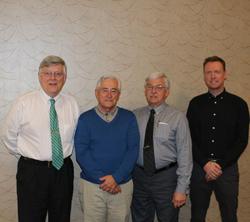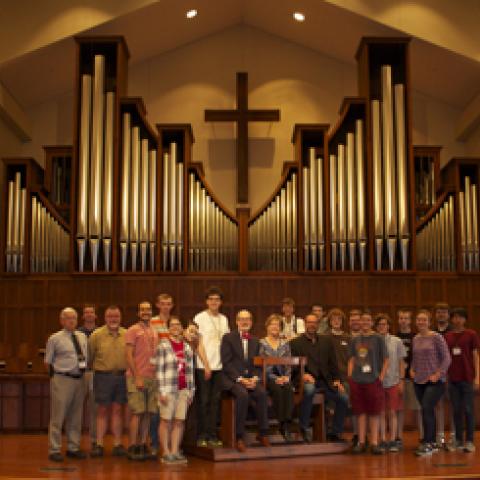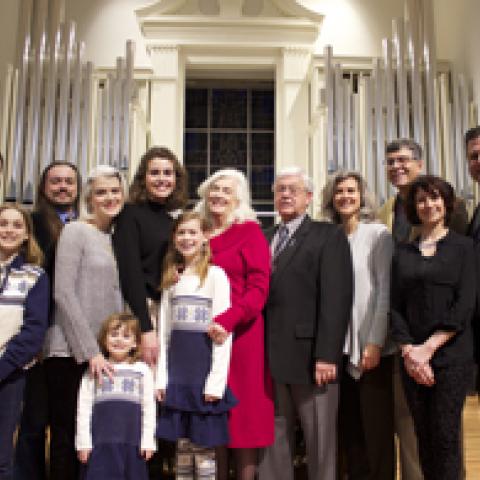The American Institute of Organbuilders held its 40th annual convention October 6–9, 2013, in Winston-Salem, North Carolina. The AIO is an educational organization dedicated to advancing the art of organ building “by discussion, inquiry, research, experiment, and other means.” AIO members are professional organbuilders, service technicians, and suppliers who subscribe to the institute’s objectives and its Code of Ethics. There are over 400 members.
Begun in 1973, the AIO continues as a vital organization with a fine board of directors, a quarterly journal, and a consistent pattern of annual conventions. The AIO awards certificates for Service, for Colleague, and for Fellow, based on tests of knowledge and understanding of organ building, similar to the AGO certifications for organ playing.
At this 40th convention, there were some 180 registrants, including 110 members. About 80 elected to stay for a post-convention trip to Durham and Raleigh. There were 21 exhibitors, five of whom were from outside the United States.
Many organists in church and/or education positions inevitably know a few pipe organ service people, some of whom are actually builders of pipe organs. Many become friends and are often of great value to organists, who must defend their instruments by educating their congregations and colleagues on why an organ has to be “fixed” and why it “costs so much.”
A few organists actually become adept at making a quick and safe fix to a problem without calling the organbuilder or maintenance people. Some higher-education institutions actually offer a course in how to take care of that one trumpet pipe that is out of tune before an important liturgy, or how to pull a pipe safely if it is ciphering, among a host of other little maladies. At the same time, plenty of service people can tell you horror stories of organists mutilating pipes with duct tape or bending them hopelessly out of shape.
When organists gather in conventions, the focus is almost always on performances of music, plus workshops on everything from fingering to phrasing, or the intrepid pursuit of performance practice, or the history and analysis of music.
How many organists know what organbuilders regard as important in their conventions? The difference in the two types of conventions—organists vs. organbuilders—is remarkable and encouraging. Despite feeling somewhat like a spy, this writer received a formal invitation to observe the 40th anniversary activities and report them to the organ-playing world. (I once enjoyed being an employee of an organ-building firm when I was a senior in high school. I learned to solder cable wires to junction boards, tune pipes, releather pouches, deal with Pilcher chests, and meet the famous consultant William Harrison Barnes! That did not make me an organ builder, but at least I understood some basics. All that was long before the computer chip.) The AIO may well be responsible for making “organbuilder” a single word.
The 40th annual convention took advantage of some remarkable historic venues in central North Carolina, in addition to superb hotel accommodations with fine facilities for meetings, exhibits, and food. What is immediately obvious is that an AIO convention is not about organ playing. Little music is heard. When visiting organs, members listen to brief sounds of individual stops. They also sing a hymn during each organ inspection.
There were some pre-convention activities in Winston-Salem. On Saturday, some members visited the 1918 Æolian Company Opus 1404 in the Reynolda House; the organ’s restoration, by Norman Ryan and Richard Houghten, is in progress. On Sunday there was a visit to the organ shop of John Farmer, followed by choral Evensong at St. Paul’s Episcopal Church with its four-manual, 50-stop Skinner organ, Opus 712, 1928, restored by A. Thompson-Allen Company. In the chapel at St. Paul’s is the two-manual, 17-stop, 2004 C. B. Fisk Opus 131, built in collaboration with Schreiner Pipe Organs, Ltd., Opus 8. That visit included looking at Fisk’s borrow actions. The pedal department of this organ has just one pedal stop and five borrowed voices from the Great manual.
On Monday and Wednesday there were a total of eight lectures in the hotel lecture room.
Scott R. Riedel & Associates
“Working with a Consultant”
Scott Riedel discussed issues in dealing with church committees—from the tensions of committees saying “too much money for music,” “fear of fundraising,” “most people go to the contemporary service and never hear the organ [not true, they go to weddings and funerals]”—to the matters of contacting builders and reviewing how to achieve the best builder for the situation.
Schreiner Pipe Organs, Ltd.
“Pedal Borrows on Mechanical Actions”
For those committed to mechanical action, John Schreiner supplied video details on how to design borrowing manual stops to be played in the pedals: “Either/Or” is one way; “And” is the other way. Those deeply engaged in mechanical-action organs found
Schreiner’s acumen most valuable.
Joseph Rotella
“Saving Green by Going Green”
Joe Rotella of Spencer Organ Company, Inc., has great interest in keeping green, thereby saving “green” money. He explored energy conservation including government subsidies, electricity, vehicles, energy audits, waste and toxicity reduction, as well as personal health, gardening, and thinking “local first.” His logo signifying “Reduce, Reuse, Recycle” is a powerful consideration for all builders.
Charles Kegg of Kegg Pipe Organ Builders, and C. Joseph Nichols of Nichols & Simpson, Inc.
“When the Client Asks . . .”
In response to the question “How many here have employed electronic sounds in your organs?” numerous hands were in the air. (As the English language changes, the use of “digital” and “electronic” is still in flux.) One of the two panelists of the discussion agreed to use electronic sounds for the bottom 12 notes of a 32′ stop; the other agreed to be judicious about electronic stops, but “the organ needs to still be an organ when you pull the plug.” The discussion was unquestionably a sensitive one across the room, and it remained frank, polite, and quite ethical.
A curious question sparked more commentary: for electronic sounds that are sampled, is there a warranty question about who owns the sound? The electronic-sound issue remains a very serious and sensitive question among organbuilders, for which there will be no immediate answer.
David Pillsbury
“Hearing Protection”
The guest lecturer was David Pillsbury, retired director of audiology and speech pathology, Wake Forest Baptist Hospital. Organ technicians must be able to hear critical things in the way an individual pipe sounds, and how they relate to each other within a rank—whether tuning or voicing. The discussion included video examples on how the ear is constructed, plus important cautions on protection, and information on the various products that provide protection.
Bryan Timm and Randy Wagner, Organ Supply Industries
“Scales and Why We Use What We Do”
Timm and Wagner provided a scholarly paper on “Scales and Why We Use Them, or, Starting with Grandma’s Meatloaf,” a fine academic analysis of how the modern organ industry has come to use the measurements of pipes, or just as importantly, how we alter those measurements. They promised to continue in the future to present the obvious next chapter: how pipe mouth dimensions are measured and employed.
John Dixon
“Portable Technology for Business”
John Dixon is a representative from ComputerTree, Inc. of Winston-Salem and Atlanta, a technology professional services corporation. He reviewed a surprising amount of information about the advantages of digital communication that lightens the load of toolboxes and contributes to meeting needs while on the job and/or maintaining the business aspects of organ technology.
Greg Williams
“Wood Finishing Techniques”
Greg Williams, a private consultant to the wood finishing and refinishing industry, presented a two-hour lecture on waterborne (not water-based) wood finishing products and detailed procedures in wood products, for organs that include pipes, cases, façades, and consoles. The discussion included the production of new wood parts as well as the frequent need for touch-up techniques when rebuilding or restoring organs.
A visit to Old Salem
On Tuesday, a short bus trip to Old Salem began in the Old Salem Visitors’ Center, a pleasant 2003 building in which an auditorium houses the 1800 David Tannenberg organ, restored by Taylor & Boody in 2003. John Boody, making use of excellent videos, talked about the restoration. Boody was most articulate and engaging in this fascinating project.
He was followed by Lou Carol Fix, who read from her publication, “The Organ in Moravian Church Music,” outlining the significant influence the Moravians had in helping establish the use of the organ in Moravian worship. Following was a Singstunde (a Moravian Song Service), for which Fix played the 1800 Tannenberg as AIO registrants sang several hymns.
Free time walking around Old Salem allowed the AIO into the Single Brothers’ House, where Scott Carpenter demonstrated the David Tannenberg 1789 one-manual and pedal, five-stop organ, restored by Taylor & Boody in 2007. Then in the Single Sisters’ House, Susan Bates demonstrated the Henry Erben 1830 one-manual, five-stop organ, restored by Taylor & Boody in 2008.
Finally, we visited Home Moravian Church, where the 1800 Tannenberg was once housed, to hear the 3-manual, 43-stop, 1959 Aeolian-Skinner Opus 1340, with commentary by John Farmer.
Some readers of this report who know Old Salem are aware there is a fine 1965 Flentrop organ in Salem College. The convention could not book the space because the Flentrop firm was contracted to be revoicing the instrument. As it happened, the work had been completed just before the convention, but the schedules could not be changed for the AIO to hear it.
St. Timothy’s Episcopal Church
Our fascinating visit to this fine modern building with a remarkably warm, resonant acoustic found the restored 1898 Hook & Hastings Opus 1801 (three manuals, 34 stops) being installed in the west gallery by John Farmer of J. Allen Farmer, Inc. The late director of the Organ Clearing House, Alan Laufman, brought this organ to the attention of Farmer, a member of St. Timothy’s Episcopal Church. Farmer removed it from a church in Massachusetts where it had been dormant for decades and was about to be destroyed along with the building. Farmer stored the organ in his home. Progress was slow—another decade—before the church embraced the concept of restoring the organ in St. Timothy’s. Despite not hearing an organ, the AIO sang a hymn anyway to enjoy the wonderful acoustic. This promises to be a remarkable installation, with completion perhaps by Easter 2014.
University of North Carolina School of the Arts
An optional jaunt over to the School of the Arts drew only a few registrants to hear the 1977 C. B. Fisk Opus 75 in a concert by four students and their professor, Timothy Olsen. The students came back early from their fall break to play on this notably aggressive Fisk. It was striking to think of the positive future of the organ world with such well-prepared talent. Performers were: high school junior Raymond Hawkins, undergraduates Pat Crowe and Christopher Engel, and graduate student Daniel Johnson.
Post-convention trip to Durham and Raleigh
On Thursday, the first stop, an hour-and-a-half away, was on Chapel Drive at Duke University in Durham, North Carolina, where the Duke Chapel remains one of our nation’s most thrilling architectural sights. There were four organs to inspect—count them—four.
First was the recent organ by Richards, Fowkes & Co. Bruce Fowkes talked about the instrument and the space it is in, the Goodson Chapel of the Duke Divinity School, a remarkably fine room with a superb acoustic. Also on hand for the demonstration of the four organs were no less than Andrew Pester and Dongho Lee (they are husband and wife), who provided excellent contributions from the four consoles.
Next was the two-manual, 21-stop, 1997 John Brombaugh Opus 34 in the small chapel, entered from the north transept of the chapel. The bottom manual is of Renaissance Italian design, and the second manual is Germanic, all in meantone temperament.
The third demonstration was on the famous four-manual, 66-stop, 1976 organ by Flentrop Orgelbouw standing proudly in the gallery at the west end of the chapel. The chapel itself was built with the infamous Guastavino sound-absorbing tile that, at Flentrop’s suggestion, was sealed with a silicone sealant. Thanks to that, the chapel indeed sounds the way it looks: idyllic.
The fourth event was the long-awaited hearing of the 1932 Æolian Company organ, Opus 1785, restored in 2008 by Foley-Baker, Inc. (See “Cover feature,” The Diapason, April 2012, pp. 25–27.) The organ has a new four-manual console to control the 6,600 pipes in five divisions, all in the chapel’s east end chancel. Once the demonstration of the stops was complete, Dongho Lee put the Dupré Prelude in B Major on the rack and thrilled the heck out of everyone.
David Arcus, who for some 30 years was Chapel Organist and Associate University Organist, left Duke University at the end of 2013. Dr. Arcus was not present for the AIO visit as he was playing a recital elsewhere.
The final part of the post-convention activity was a visit to three recent organs in nearby Raleigh.
The first stop was the Church of the Nativity, where the 2007 Andover Organ Company, Opus 115, two manuals, twenty stops (eight prepared), was demonstrated in the small worship space.
Our second stop was at St. Michael’s Episcopal Church, where Kevin Kerstetter proudly demonstrated the three-manual, 47-stop 2012 Nichols & Simpson, Inc. organ.
The last visit was to the Hayes Barton United Methodist Church, where the 2010 three-manual, 43-stop Buzard Pipe Organ Builders Opus 39 is installed. The demonstration and singing of a hymn was led by no less than the builder’s son, Stephen Buzard, assistant organist of St. Thomas Church Fifth Avenue in New York City. Following that, Stephen Buzard rendered a stunning performance of Edward Elgar’s Sonata in G Major, op. 28, featuring the organ’s symphonic character.
That the AIO is 40 years old and clearly a valuable asset to the organ building industry calls for celebrating this milestone. Matthew Bellocchio of the Andover Organ Company and AIO President steered the banquet festivities with great sensitivity. His faith in convention chairman Stephen Spake, of the Lincoln Pipe Organ Company, was a mark of genius. Spake carefully and lovingly steered all the matters of keeping the convention on schedule, counting heads on buses, handling Q & A sessions with a portable microphone, and constantly remaining calm, contributing to a successfully run convention. He also played an important role in the planning committee.
One might wish that the AIO would approach matters of the performance of organ literature more seriously, but then when one thinks what organists really want to know about pipe metals, leather, how pipes are measured, etc., the argument becomes nebulous. The two professions are individual art forms with totally different schools of knowledge required. The goal is for the two to meet in agreement of making sounds that convert souls and enhance the artistic excellence that humans are capable of creating. ν
Photo credit: Harry Martenas




